The Atlantic Wind Power Panel Wrap-up and Resources
May 21, 2012 Event Write-up
New York's Prospects for Offshore Wind
Held at New York Institute of Technology, the Atlantic Wind Power Panel sponsored by Cleantech Corridor, McCarter & English and the Sallan Foundation, considered New York's prospects for offshore wind energy.
Moderators: Sarah Biser, Partner — McCarter & English, Ran Kohn, Executive Director, — Cleantech Corridor
Speakers:
- Markian Melnyk, President and Founder — Atlantic Wind Connection
- Tim Daniels, Sr. VP for Market Development — Deep Water Wind
- Robin Shanen, Project Manager — NYPA
- Charles Komanoff, Director — Komanoff Energy Associates
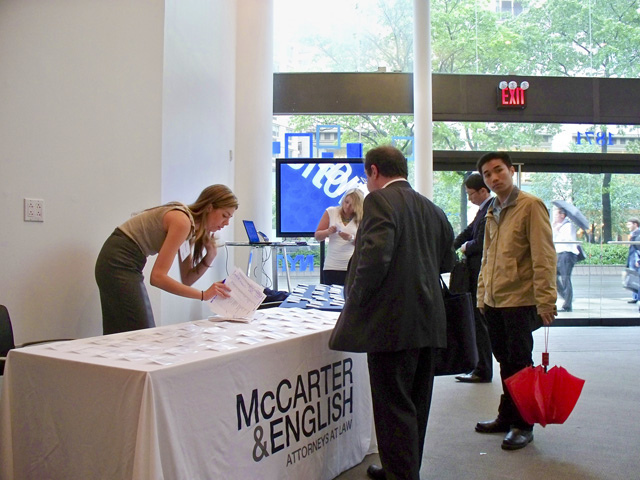
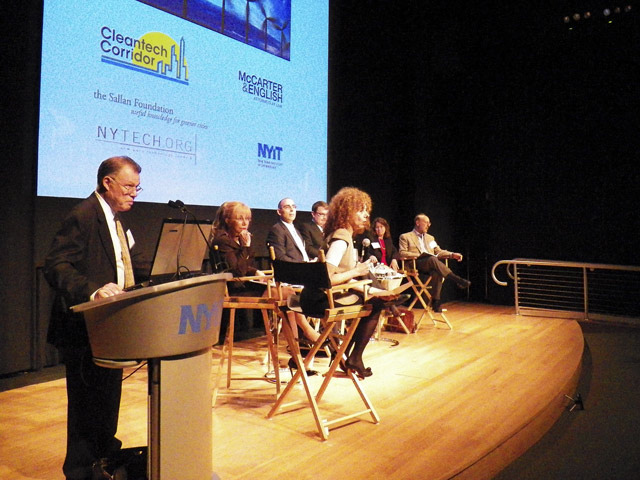
Anderson's intro frames the debate... Confronting climate change is a "wicked problem". So is building renewable energy alternatives. Definition: "A wicked problem is a problem who's solution requires a great number of people to change their mindset and behavior."
This implies:
- Various stakeholders have differing views of acceptable solutions and social complexity is at as much a feature of a WP as technical complexity;
- Problem solving generates waves of consequences BUT for WPs it's impossible to know how all at the consequences of implemented solutions will play out; and
- Finally, how then is a WP solved? Often when public exhaustion with an issue changes the political agenda to something else, but that's not the same thing as a solution.
Tonight, as you think about the prospects for the advancement of wind power and the 800 pound gorilla of today's super-cheap natural gas, ask yourselves — is solving the 21st century problem of making the transition from the world's addiction to fossil fuel another wicked problem?
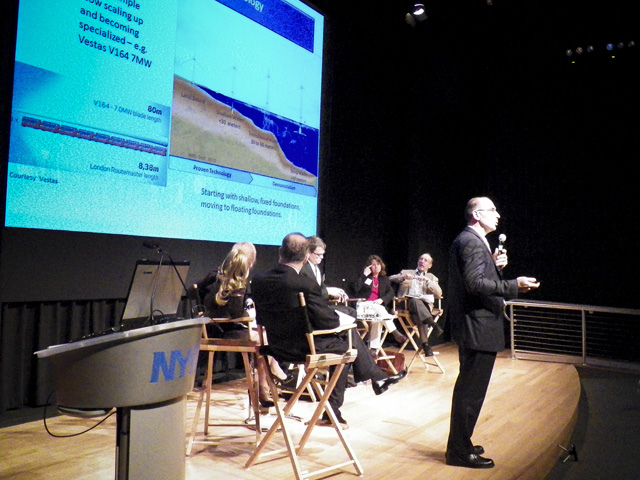
Atlantic wind is near to east coast dense populations. Markian Melnyk, President of Atlantic Wind Connection shows NREL map, calls it a "political map". Most land based wind comes from the mid-west — relying on that source won't keep jobs or $$ on the east coast. The Vestas model of business development is like the land-based wind model — scale up and become specialized. The equipment is getting a lot bigger.
According to the DOE, the cost of offshore wind development will go down as energy production goes up. This implies that the sale and/or size of equipment will limit on-shore development.
Transmission is a rising opportunity to create value because electricity is a commodity that is made and used simultaneously and must be in balance. Generation and supply. AWC can shift electricity around the grid to where it is needed now (through the spine and interconnections to several locations). The ACW plan is to connect to VA, MD, NJ and DE, with PJM as the transmission line provider. Not NY — interconnection through NYISO isn't happening.
AWC is financially backed by Google, Elia (Belgian grid group), Good Energies etc.
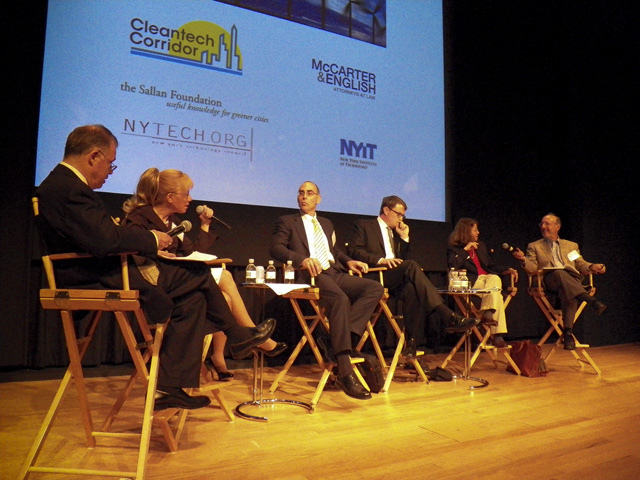
Ran Kohn as moderator jumps in with an impromptu Q&A
- Q What does DOI mean by its finding of no competitive uses?
- A AWC is the only firm interested in leasing the outer continental shelf space, so no auction will be needed.
Sarah Biser follows up and sets off a free wheeling discussion
- Q How did Google become an AWC investor?
- A Google supports renewable energy as a corporate policy. It's got a 40% interest in a $40 million development budget. The $5 billion figure that's out there would be for overall project costs.
Robin Shanen
LI offshore wind project does face competing users of the sites they want. Today, wind farm turbines must be spaced at least a mile apart and there will be NO exclusionary zones. This should overcome the problem of other users, because they won't be excluded.
Tim Daniels
True, offshore wind is more expensive than on-shore turbines — the maintenance and repair in a marine environment is really a tall order, but the price will come down with experience. And, with scale, offshore power will become sellable. Ballpark estimate $4,000/installed kW. Also, offshore power generated much more of the time than onshore 45-50%
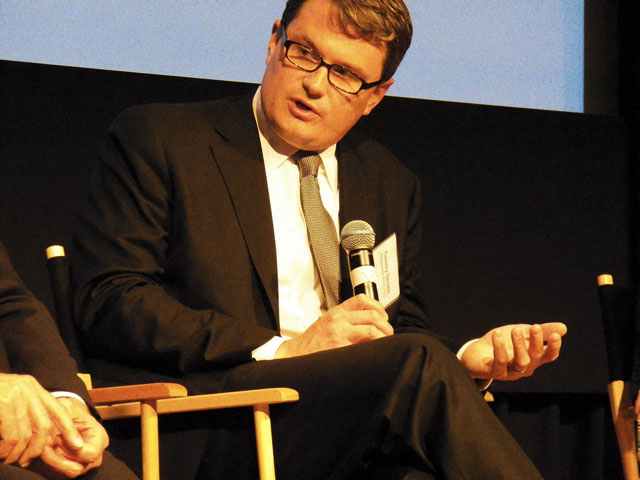
Charles Komanoff
If $4,000/kW, this amortizes to $400/kW/year and at 35,000 hours in operation/year this becomes 10 cents/kW. How can this compete with natural gas?
Tim Daniels
Don't compare current fossil-fuel generated power costs to wind costs. Why? TD expects lots of old power plants to be retiring soon and the capital cost of replacement will change cost calculations. Construction of NEW natural gas plants is very expensive in our region. To recover these costs he expects power to be 8-9 cents/kW.

Komanoff
Gets up and presents 5 slides. Worldwide energy sources by 2030 599,000 MW and 50% of ths could come from wind. He forcefully says and repeats that we have to transcend our NIMBY ethos to solve our energy needs.
- Biser Q Post-closure clean up costs?
- Melnyk A federal requirement already sets aside $$ for this.
Komanoff
From 2007 to 2011 coal's share of the actual energy produced has declined 14%, while wind increased 248% (tiny base and tiny total). From 2000 to 2011 wind power grew faster than the comparable boom years for nuke power growth (another slide). We need policies to promote US wind power, including pilot projects so we can learn from experience and a pro-active government policy to ban where needed, regulate and enforce and fine where permitted. Also calls for feed-in tariffs, renewable power and a carbon tax.
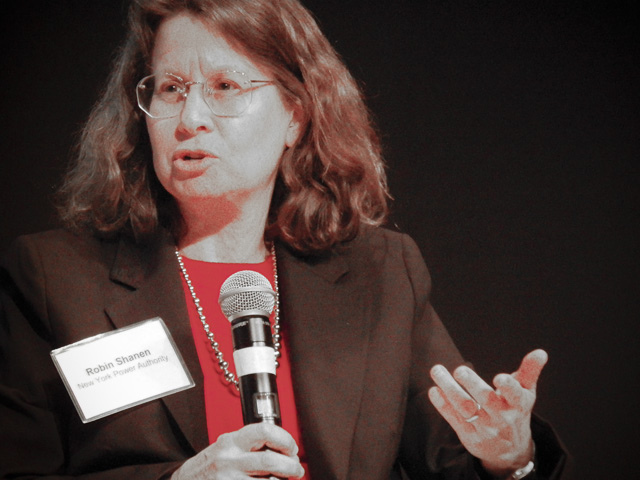
Shanen
Wind is intermittent and gas plants can be fired up and energy dispatched on line very fast — doesn't see gas and wind as competitors but as complimentary.
Daniels
Lots of Renewable Portfolio Standard state-level requirements have been driving investment in renewables. Since PUPRA, the federal government has not done much for renewables.
Shanen
Some electricity prices are establishes at auction sales with the auction "clearing price" knocking out the highest price bidder.
Shanen
This is called "price suppression" and is cited as a value of wind for consumers because the loser is the highest price bidder.
Daniels
Anticipated retirement of older plants along the Atlantic coast, including retirement of some NYC plants and potentially Indian Point are significant for this area's energy future.
Komanoff
It is easy to overestimate the benefits of EPA tightening CAA emissions rules for coal (although it's a good thing). But how much will how much will higher costs drive fossil fuel sources from the ISO/auction dispatch list? Still need a carbon tax to ad to the push.
Moderator Biser Questions Panelists
- Biser Q Why isn't NY part of the AWC?
- Shanen NYPA/LIPA pursuing an offshore lease that would be transferred to a private developer.
- Melnyk We must deal with PJM and PJM and NYIO have not figured out how to allocate project costs — so it's too hard to bring NY in for now.
- Biser Q Upcoming technologies for offshore wind?
- Shanen Energy storage
- Daniels Wind is a fairly mature technology now (after lots of European investment and innovation over the last 20 year, so don't expect any big cost-cutting technologies coming through soon. In Europe 3,800 MW of wind power on-line now and another 19,000 MW are in the pipeline, should be operational in 8–10 years.
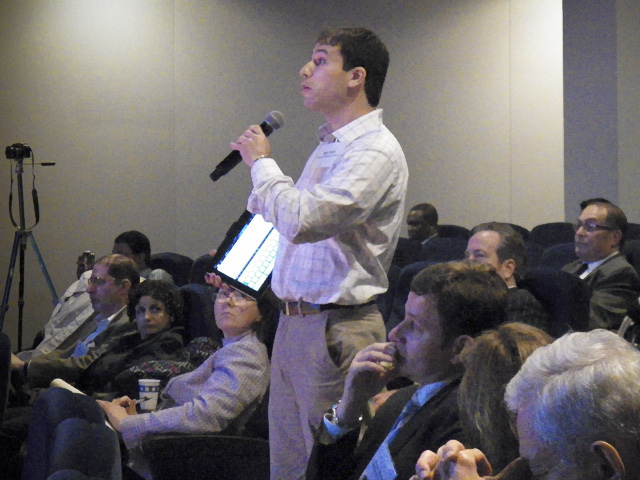
Moderator Biser Opens Up Floor
- Q 1 Impact on sea animals — like whales
- Melnyk Noise of construction related to pile driving is the big problem and pile driving can be avoided through other ways of building. Expect first phase of AWC operation 2018–2019.
- Q 2 Can NY get an RPS carve out for wind, the way there is for solar?
- Daniels We're a bit behind right now since upstate on-land wind is now the cheapest. Without a carve out off shore will remain price challenged.
- Komanoff RPS is a lame/idiotic tool compared with a carbon tax, which will let the market decide on energy source choices. Want to shrink the fossil fuel share of the energy budget by 70%
- Melnyk AWC supply chain — there's a state-of-the-art cable company being built in South Carolina, but most of the other equipment comes from Europe. Also blades and parts assembly work will be more done here.
- Daniels ... construction jobs are for US workers.
- Q 3 Will NYPA respond to the RFI from the Cuomo energy highway project in relation to its offshore wind project?
- Shanen We're thinking about it...
- Daniels The Energy Taskforce said they are open to offshore wind, but he has doubts about the Governor's enthusiasm on this front. Still, there could be a place for off-shore wind in the Energy Highway project mix.
Footnotes
- Plumer, Brad. "Are We Wildly Underestimating Solar and Wind Power?" The Washington Post, 19 June 2012, https://www.washingtonpost.com/news/wonk/wp/2012/06/19/are-we-wildly-underestimating-solar-and-wind-power/ ↩
- Oremus, Will. "The Latest Wedge Issue in the Presidential Campaign: Wind Power?" Slate Magazine, Slate, 15 Aug. 2012, https://slate.com/technology/2012/08/wind-power-growing-fast-in-u-s-but-romney-would-end-production-tax-credit.html
Presentations for Download
The Panelists have graciously made their presentations available for download:
Markian Melnyk, President and Founder — Atlantic Wind Connection
M_Melnyk-Building_an_Industry_with_AWC-CleanTech_Corridor-May_2012.pdf PDF Download [ 2.1 MB ]
Tim Daniels, Sr. VP for Market Development — Deep Water Wind
T_Daniels-Deepwater_Wind-CleanTech_Corridor-May_2012.pdf PDF Download [ 1.2 MB ]
Robin Shanen, Project Manager — NYPA
R_Shanen-NYPA-CleanTech_Corridor-May_2012.pdf PDF Download [ 4.5 MB ]
Charles Komanoff, Director — Komanoff Energy Associates
C_Komanoff-NYIT-CleanTech_Corridor-May_2012.pdf PDF Download [ 64 KB ]
Deep Water Wind
Comments on the Scope of the 2013 NYS Energy Plan PDF Download [ 1.2 MB ]




